
10 minute read
Wild at Heart
At first glance Roushanna Gray’s immediate living and working environment is harsh and unforgiving, but this passionate wild food forager loves sharing just how rich in edible treasures her Cape of Good Hope surrounds are.

ABOVE: Just a few minutes of picking yields a beautiful selection of floral confetti, ready to be used in the dishes of the day. 'The great thing about edible flowers is that many of us already have them in our gardens and if not, they are generally really easy to grow'. BELOW: Nasturtium flowers, lacey coriander flowers and nasturtium pods add intense flavour and beauty to a green salad. Red cabbage cups make perfect edible salad bowls too, while bright Calendulas bring arresting contrast to the feast.
RIGHT: The indigenous flowering shrubbery of the Western Cape is reliant on fire to propagate, there are an estimated 8,000 species of fynbos plants.
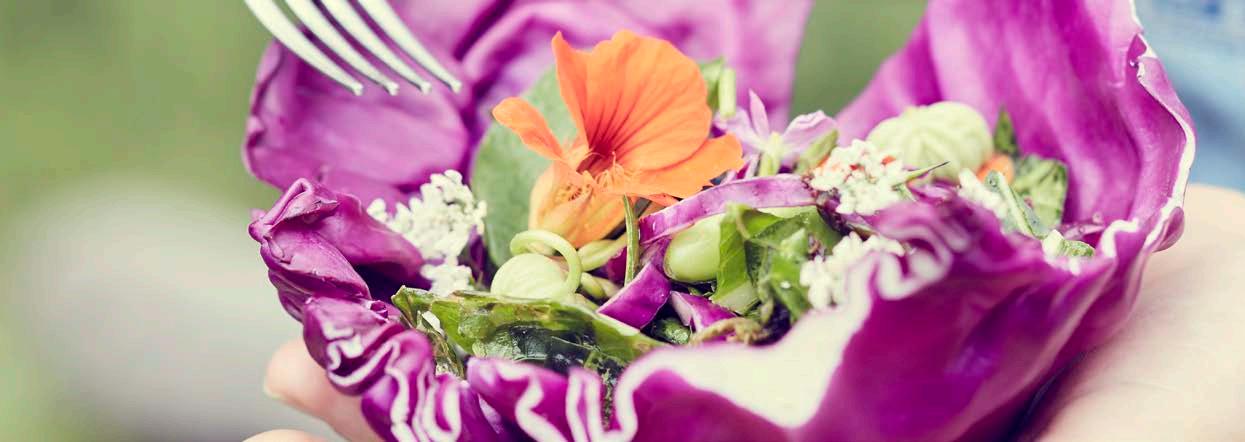
If provenance is the food world’s holy grail, then Roushanna Gray’s Veld and Sea classroom is a temple to the movement. 'Veld' means 'field' in Afrikaans but a more accurate description is wild, untouched vegetation. This is especially true of Cape Point, the most southerly point of the famed Cape of Good Hope where Roushanna and her family live. Part of the Table Mountain National Park and home to one of the most biodiverse indigenous plant kingdoms in the world, this protected reserve area is characterised by a treacherous coastline, a landscape carpeted in indigenous fynbos (the local term for the heather-like flowering plant covering) and wild, wild winds. One is truly at the mercy of the elements here. Whether you visit in winter or summer, rain or shine, it is an unrelenting environment featuring a rocky coast that has claimed many passing ships over the centuries. Some 400 years ago, when the Dutch colonists settled in the Cape to grow produce for the passing sea trade, they relied heavily on the local populace for guidance on where to source indigenous edible offerings and equally, what was safe to eat. Crops failed, the weather didn’t play ball and relying on local knowledge was essential to their survival. Much of this information has been lost over the centuries except for a growing group of enthusiasts, like Roushanna, who are intent on rediscovering and sharing their often delicious and always fascinating findings.
The rustic home she shares with her husband, garden landscaper, Tom and their children, Tai and Rubi, is on the same property as the Good Hope Nursery, founded by her indigenous gardening icon and mother-in-law, Gael. Plants and trees that you would be hard-pressed to find in commercial nurseries are the order of the day at this bastion of local flora, and amongst waterwise, pro-indigenous gardeners, it has become a beacon of planting in accordance with the Cape climate. In recent years, people have made the effort to visit this farflung nursery, some 60kms from the city, for another reason – Roushanna’s sold-out Veld & Sea wild food foraging expeditions. Like any chef worth their salt, Roushanna is on a continuous quest to discover new edible opportunities and in her case - wild food flavour marriages. For those lucky enough to attend her Veld & Sea experiences, it’s a journey that yields many treasures to share. Scheduled a few times a month on the weekends and during the week by appointment only, the half day experiences involve fascinating wild food, flower and herb gathering missions in the fynbos-lined slopes up above the nursery and forays into nearby rockpools to gather mussels and whatever other offerings the ocean might yield that day. After a morning of hunting, gathering and absorbing fascinating morsels of information from Roushanna, guests return to the Veld & Sea classroom to prepare a feast featuring their bounty. 'The entire experience is dictated by the seasons and the moonphases that determine the tides. I devise a menu according to what is prolific at that time of year and we go out looking for these and other edible elements essential to the different dishes on the menu. After that we come back and break into groups to prepare for lunch. It's a really interactive experience and people love discovering that plants they’ve never heard of, as well as quite alien things, like seaweed are so delicious', says Roushanna who gives us mouth popping, peppery nasturtium pods to sample while we chat. In the winter months, pungent pine ring mushrooms are the prized harvest while in the summer, delicious delicacies from nearby rock pools and nutritious sea vegetables provide a taste of what the ocean has to offer.
Luckily for Roushanna there is a wealth of knowledge available for those who seek information on wild food foraging. The internet, local experts and both historical and recent books alike yield regular fascinating discoveries for this intrepid hunter-gatherer who says she learns something new every time she ventures out on a walk. 'When I first moved here I had no idea what I was doing, I went off into the veld and picked a pretty bunch of flowers, and came back to proudly show my family only to discover I had picked some rare endemic flower. Now I only pick what I know grows prolifically and does not suffer from being cut back a little', she says.
For added flavour, colour and for medicinal uses too, Roushanna has planted a variety of edible flowers in the family’s vegetable garden, and workshop participants are given equally interesting insight to the further layers of flavour these can bring to many dishes. From pansies with their grassy fresh taste, to sweet and spicy cornflowers and piquant calendulas, many flowers, we learn, can bring fascinating and mouthwatering depth to food while beautifying things as well. 'We eat with our eyes as much as we do with our mouths', says Roushanna, as she adds delicate white coriander flowers to a salad. There are plenty of edible flowers that make excellent partners to drinks too. 'Chamomile is known for its calming properties and is wonderful in a honey syrup which you can add to gin and tonic or bubbly, while pelargoniums come in an array of delicious flavours like rose, lemon and peppermint and the leaves make a refreshing and uplifting iced tea', she says. Although it is these nuggets of information that workshop participants take home with them, there is so much more to be had from attending a Veld & Sea day. Unplugging from technology and returning to an ancient way of sustenance, if only for a short time is immensely gratifying. 'Gathering is part of our DNA, we’ve just forgotten about it. I’m glad I can help people rediscover the joy it can bring'. PROJECT INFO:
TEXT
Vicki Sleet
STYLING
Sven Alberding
PHOTOGRAPHS Warren Heath
www.veldandsea.com
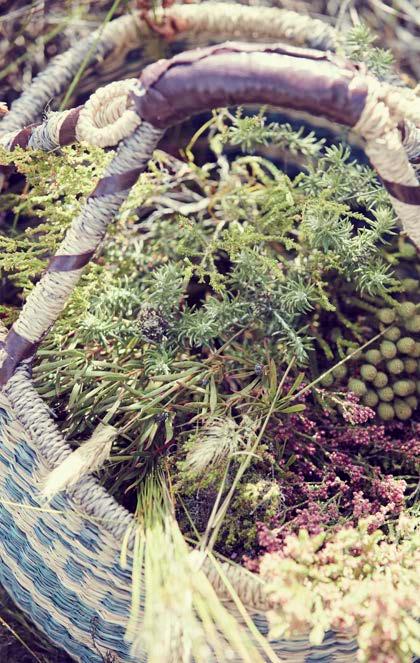
Menu
• Asparagus and farm eggs on a nest of chickweed with anchovy butter and flower petal salt • Glass spring rolls with a sweet and sour dipping sauce • Rainbow carrot cake with lemon buttercream icing strawberries and edible flowers • Chamomile cocktails with flower ice
FLOWER FLAVOURS
• Pansies - Viola spp. Flavour – grassy, fresh • Dianthus - Dianthus plumarius. Flavour – clove, spicy • California poppy - Calendula officinalis. Flavour – grassy, fresh • Cornflowers - Centaurea cyanus. Flavour – sweet, spicy • Borage - Borago officinalis. Flavour – cucumber, sweet • Nasturtiums – Tropaeolum. Flavour – peppery, spicy, sweet • Chamomile - Anthemis nobilis. Flavour – fresh, grassy, apple • Calendula - Calendula officinalis. Flavour - spicy, piquant • Pelargonium - Pelargonium spp. Flavour – Grassy, fresh • Wild pea - Dipogon lignosus. Flavour – sweet, fresh, pea
FLOWERS IN DRINKS
• California poppies make a mild and gentle sedative tea, calming and good for bedtime. • Borage is lovely for flavouring water, and with its cucumber flavour it pairs well with gin. • Nasturtiums and Calendula are peppery and spicy and work well as a colourful and flavoursome garnish with chai tea. Steep Calendula petals in gin for a spicy, healing, golden drink. • Chamomile is known for its calming properties, is wonderful in a honey syrup and in iced tea at the end of a hot day.
DRIED FLOWERS
If you want to store your flowers for use out of season, pick your flowers and dry them on a paper covered tray on a sunny windowsill. Once completely dry, store them in an airtight jar or container in a cool dark place.
Claudia Uffhaus, Pippa Williams and Roushanna Gray in front of the Veld & Sea classroom.
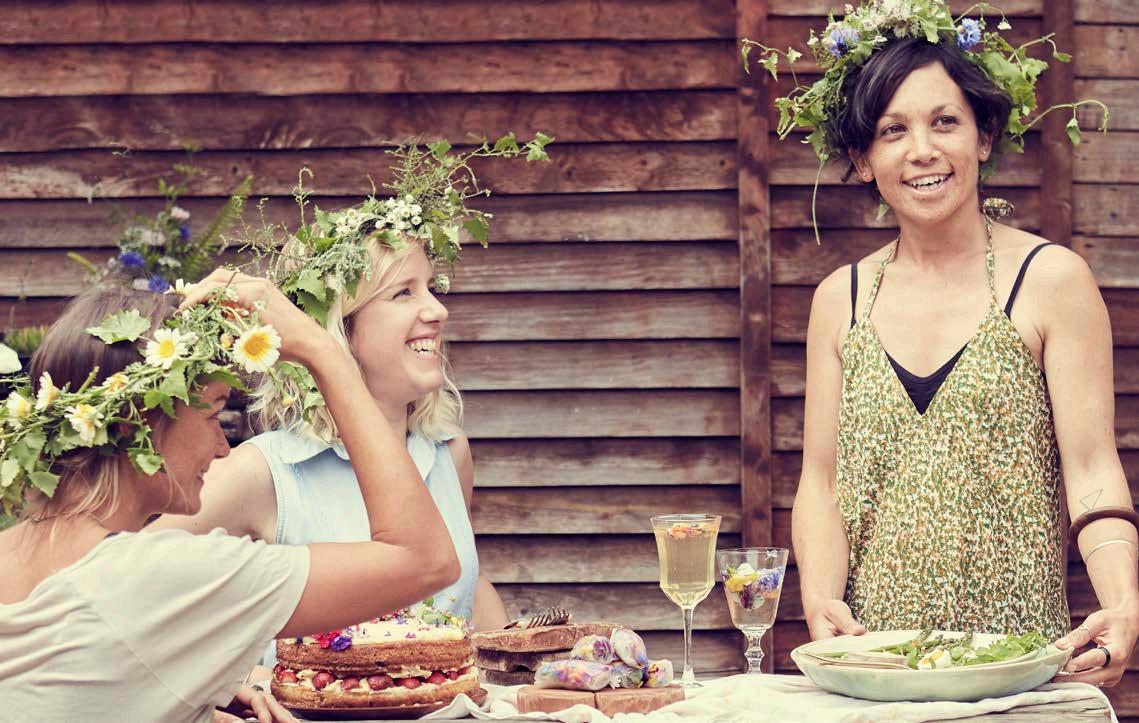
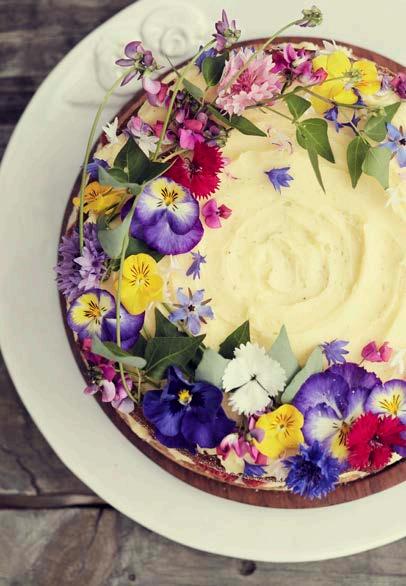


RAINBOW CARROT CAKE
2 eggs 2 cups of sugar 6 tsp cinnamon 2 cups of oil 3 cups of flour 6 tsp baking powder A pinch of salt 4 cups of grated carrots 1 cup of mixed raisins
METHOD:
Beat the eggs and sugar until creamy and light in colour. Add all the rest of the ingredients except the fruit and mix well. Carefully fold the fruit into the cake mixture and pour into two greased cake tins. Bake in a preheated oven at 180°C for about 40 mins or until a knife comes out clean. While the cake is cooling, whip up a batch of your favourite lemon/lime butter-cream/cream-cheese icing and divide into three. Ice the top of the first cake, adding a layer of chopped strawberries and cover with more icing. Sandwich the second cake on top and dust the sides with icing sugar. Ice the top and decorate with edible flowers.
SPRINGTIME ASPARAGUS DISH
1 bunch of asparagus 1 tbs olive oil 4 farm eggs 100g butter 6 anchovies 2 tbs sea salt flakes 1 sprinkle of dried flower petals 1 handful of foraged chickweed
METHOD:
To make the anchovy butter, blend the anchovies in softened butter until you reach a smooth consistency. Fill little butter dishes and put in the fridge to set. For the flower salt, mix the sea salt and flower petals and serve in a little bowl. Lightly steam the asparagus for about 4 mins. Do not overcook as you want to retain the green colour and crisp texture. Toss in olive oil before serving. Soft boil the farm eggs, peel and place on the chickweed and serve with asparagus, anchovy butter and flower salt. For a heartier meal, include a basket of sliced assorted farm breads.
CRYSTAL RICE PAPER SPRING ROLLS
6 rice paper spring roll wrappers bowl of water A selection of edible flowers 1 avocado, sliced Sprouts ½ cup red cabbage, sliced ½ cup carrots, julienne ½ cup sweet peppers, julienne
METHOD:
With all your ingredients at hand, soak a rice paper wrapper in the bowl of water until soft. Place on a wooden board and and fill with ingredients. Remember to work backwards in terms of how you want the design to come out – I start with the pretty flower petals first and then layer with veg. Fold the top and bottom sides over the filling and then fold the left side and then the right until you have a snug package. Serve with a sweet chilli dipping sauce.
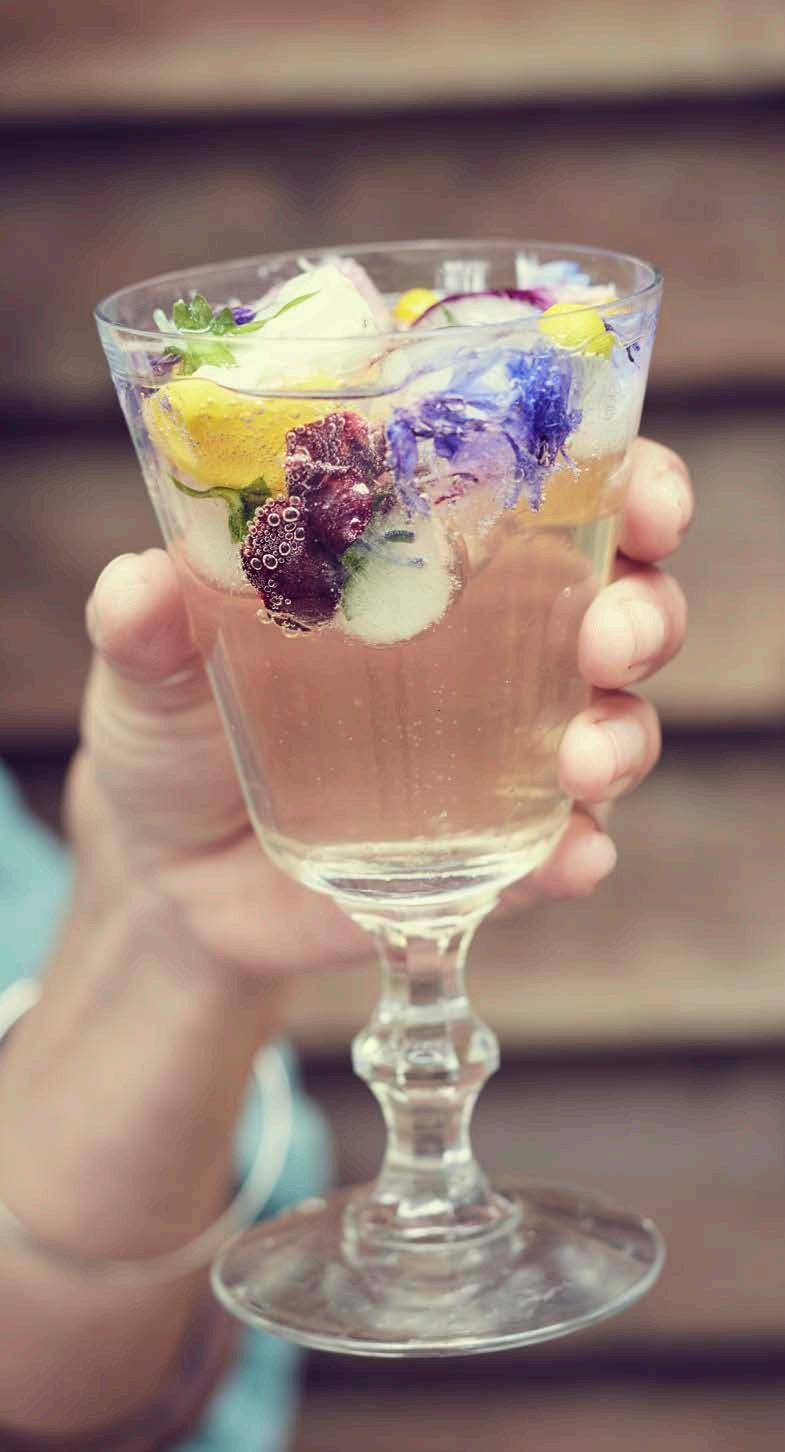
CHAMOMILE COCKTAILS + FLOWER ICE
To make the Chamomile syrup
½ cup of dried or fresh Chamomile flowers or two Chamomile teabags ½ cup of honey 1 cup of water
METHOD:
Place all the ingredients into a small pot over a low heat. Bring to the boil and then gently simmer for about 15 mins. Remove from heat and strain through a sieve, squeezing the syrup out of the plants/teabag with a spoon against the sieve and decant into a sterilized bottle.
To make the cocktail:
3 tbs Chamomile syrup 1/3 cup of sparkling wine Good quality tonic water 1 Lime
METHOD:
Pour the syrup and sparkling wine into a glass, top with tonic, add a squeeze of lime and pop in a few flower ice cubes.










